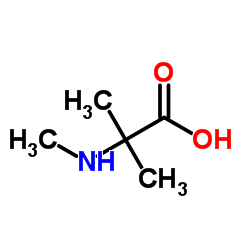Differential influence of cAMP on the expression of the three subtypes (ATA1, ATA2, and ATA3) of the amino acid transport system A.
T Hatanaka, W Huang, R G Martindale, V Ganapathy
Index: FEBS Lett. 505(2) , 317-20, (2001)
Full Text: HTML
Abstract
Treatment of HepG2 cells with forskolin led to 60-100% stimulation of system A activity, measured as the Na+-dependent uptake of alpha-(methylamino)isobutyric acid. The stimulation was reproducible with cholera toxin and dibutyryl cAMP, and inhibitable by H7, a non-specific protein kinase inhibitor. The stimulatory effect was eliminated by cycloheximide and actinomycin D. The forskolin effect was associated with an increase in the maximal velocity of the transport system, with no change in substrate affinity. These cells express three different subtypes of system A (ATA1, ATA2, and ATA3). Treatment with forskolin increased the steady-state levels of ATA1 and ATA2 mRNAs, but decreased that of ATA3 mRNA.
Related Compounds
| Structure | Name/CAS No. | Molecular Formula | Articles |
|---|---|---|---|
 |
N,2-Dimethylalanine
CAS:2566-34-9 |
C5H11NO2 |
|
Three-dimensional quantitative structure-activity relationsh...
2011-11-01 [Bioorg. Med. Chem. 19 , 6409-18, (2011)] |
|
Unique antitumour effects of L-2,4 diaminobutyric acid on cu...
2003-01-01 [Anticancer Res. 23 , 1245-1248, (2003)] |
|
Integrin participates in the effect of thyroxine on plasma m...
2013-03-01 [Biochim. Biophys. Acta 1830(3) , 2629-37, (2013)] |
|
Functional activity of a large neutral amino acid transporte...
2008-01-22 [Int. J. Pharm. 347(1-2) , 23-30, (2008)] |
|
Transport of large neutral amino acids into BeWo cells.
2000-01-01 [Placenta 21(5-6) , 558-64, (2000)] |